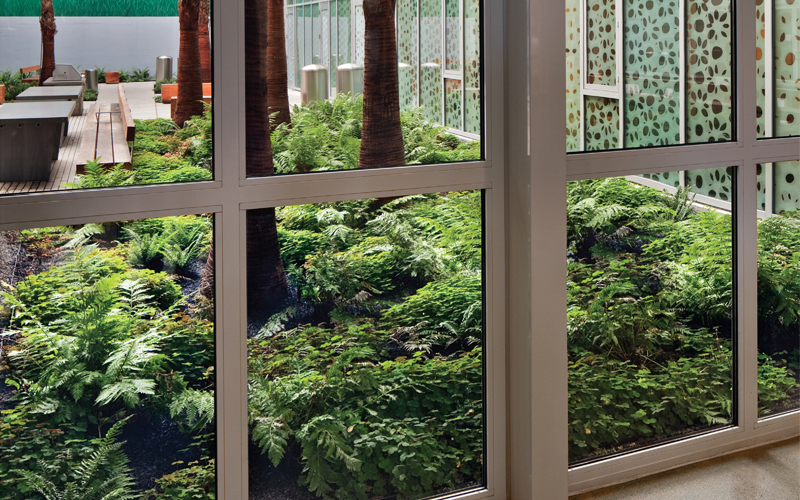Professional Practice
Improving Water Efficiency: Residential Rain Gardens
 The entry lobby overlooks a fern rain garden. ËżąĎĘÓƵ 2012 Professional Residential Design Honor Award. Drs. Julian and Raye Richardson Apartments, San Francisco, California / Andrea Cochran Landscape Architecture
The entry lobby overlooks a fern rain garden. ËżąĎĘÓƵ 2012 Professional Residential Design Honor Award. Drs. Julian and Raye Richardson Apartments, San Francisco, California / Andrea Cochran Landscape Architecture Rain gardens are a depressed vegetated area that use rainfall and stormwater runoff as irrigation. Rain gardens capture and hold water, usually through the use of native plants. By using highly-porous plant materials, rainfall and stormwater runoff can drain more effectively. Rain gardens allow approximately 30 percent of runoff to be filtered into the ground. A properly-designed rain garden can filter one inch of rainfall in four hours.
Instead of extending conventional water infrastructure at great cost, rain gardens can be used to collect rainwater, store it at the residential level, and reduce residential stormwater runoff. Like bioswales or bioretention ponds, the main role of rain gardens is to reduce water flow and limit water volume. Rain gardens also filter stormwater pollution, around 90 percent of copper, lead and zinc; 50 percent of nitrogen; and 65 percent of phosphorus, which could otherwise flow into storm drains and eventually bodies of water.
Homeowner can maximize the effectiveness of rain gardens by improving the quality of soil on their property. Green infrastructure and stormwater management systems are essentially useless if the soil has been degraded and compacted, reducing the flow of water and air, and restricting root establishment. provides credit for using innovative soil remediation techniques, like , to improve the ecosystem function of their soil.
Sources: , Rutgers University;
Organizations
Research
"," Terry Wallace, Schiffer Publishing, 2008
ˇ°d,ˇ± Lynn M. Steiner & Robert W. Domm, Voyageur Press, 2012
How-to Guides
, Low Impact Development Center
, Erie County Conservation District
, University of Wisconsin Extension
, Virginia Department of Forestry
Resources
, Water Resources Program, Rutgers New Jersey Agricultural Experiment Station
, Rutgers University
, Cornell University Cooperative Extension
, UMass Amherst, The Center for Agriculture, Food and the Environment
Government Resources
, City of Gresham, Oregon
, County of Washtenaw, Michigan
, Burnsville, Minnesota
, City of Seattle & King County, Washington
, City of Seattle & King County, Washington
, City of Kirkland, Washington
, City of Everett, Washington
, City of Fort Wayne, Indiana
Projects
Private Residential Garden, Minneapolis, Minnesota
Oslund.and.assoc., Minneapolis, Minnesota
Drs. Julian and Raye Richardson Apartments, San Francisco
Andrea Cochran Landscape Architecture
Maple Hill Residence, Westwood Massachusetts
Stephen Stimson Associates Landscape Architects
Woodland Rain Gardens, Caddo Parish, Louisiana
Jeffrey Carbo Landscape Architects
Bud Clark Commons, Portland, Oregon
Mayer/Reed